University Assignment: Comprehensive Summary of HBR Articles
VerifiedAdded on 2021/04/19
|6
|1102
|231
Homework Assignment
AI Summary
This assignment offers a comprehensive summary of an HBR article that contrasts how organizations manage finance and human capital. The article highlights the importance of treating human capital with the same care as financial assets. The summary also includes answers to questions related to talent management, such as evaluating employees' fit with organizational culture, the 'make or buy' approach to talent acquisition, strategies for attracting and retaining talented workers, and specific requirements for the banking sector. The student provides insights from the article and supplemental readings, emphasizing the need for investment in human capital, employee retention, and tailored talent management strategies. The assignment underscores the importance of understanding and adapting to organizational culture and the value of attracting and retaining top performers.
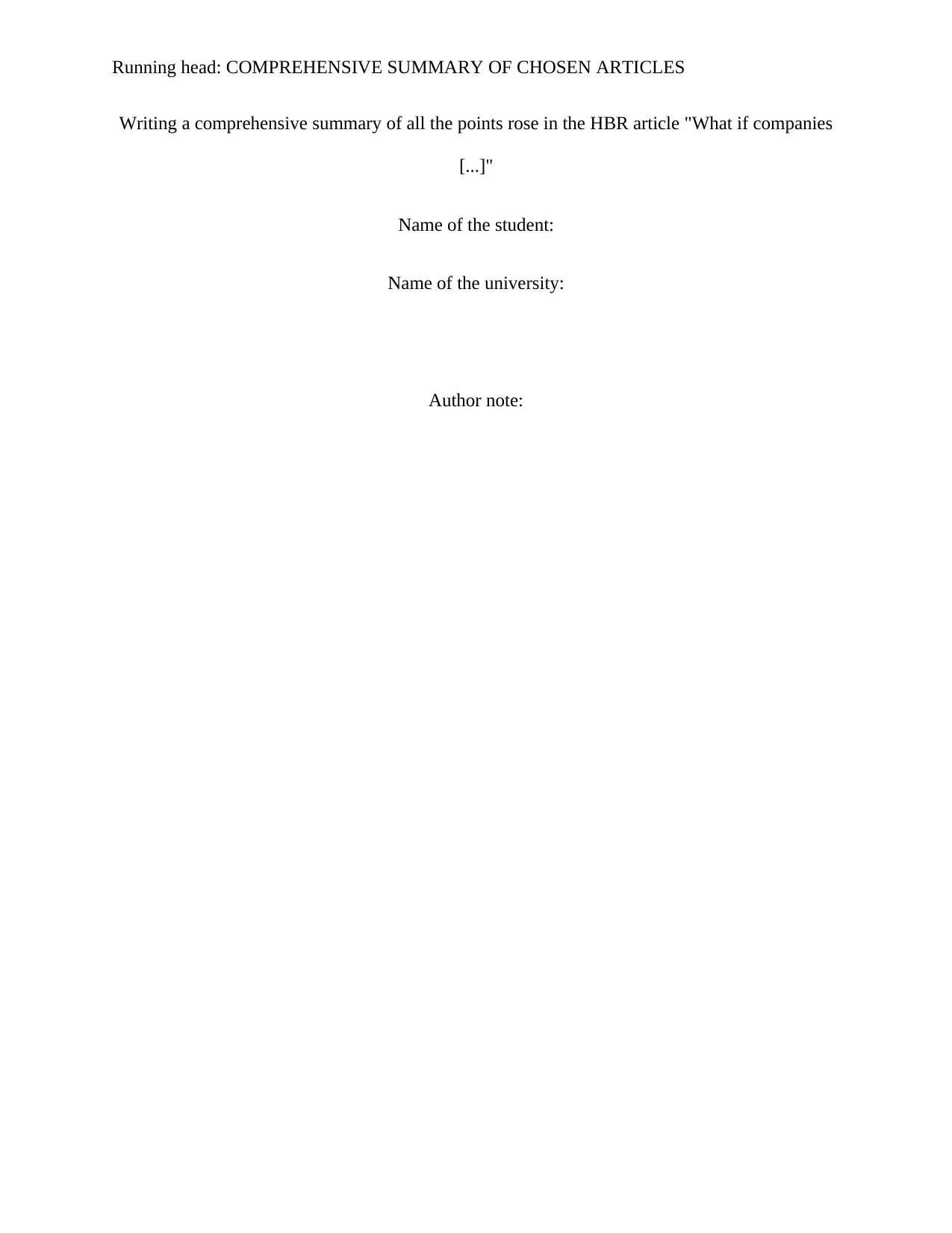
Running head: COMPREHENSIVE SUMMARY OF CHOSEN ARTICLES
Writing a comprehensive summary of all the points rose in the HBR article "What if companies
[...]"
Name of the student:
Name of the university:
Author note:
Writing a comprehensive summary of all the points rose in the HBR article "What if companies
[...]"
Name of the student:
Name of the university:
Author note:
Paraphrase This Document
Need a fresh take? Get an instant paraphrase of this document with our AI Paraphraser
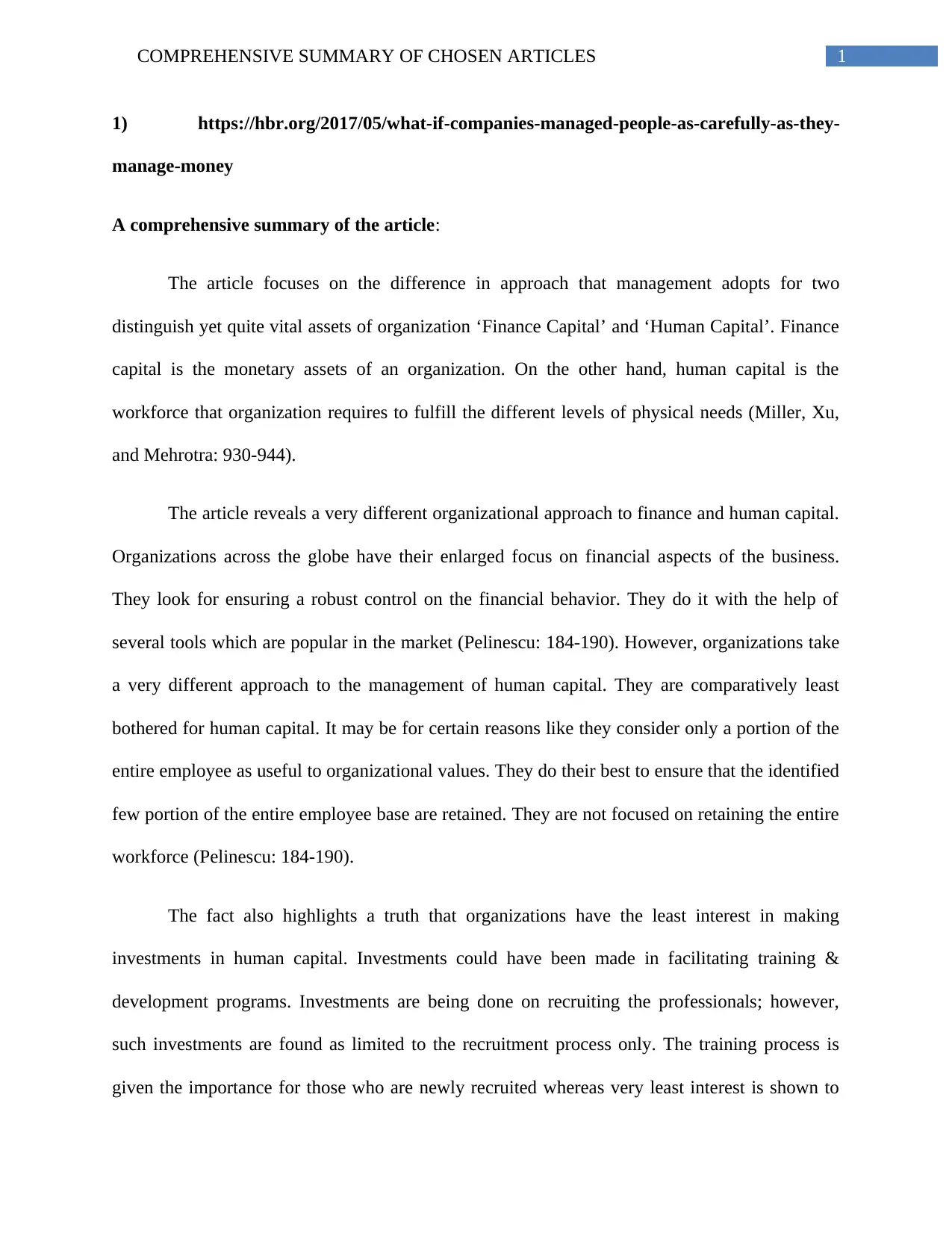
1COMPREHENSIVE SUMMARY OF CHOSEN ARTICLES
1) https://hbr.org/2017/05/what-if-companies-managed-people-as-carefully-as-they-
manage-money
A comprehensive summary of the article:
The article focuses on the difference in approach that management adopts for two
distinguish yet quite vital assets of organization ‘Finance Capital’ and ‘Human Capital’. Finance
capital is the monetary assets of an organization. On the other hand, human capital is the
workforce that organization requires to fulfill the different levels of physical needs (Miller, Xu,
and Mehrotra: 930-944).
The article reveals a very different organizational approach to finance and human capital.
Organizations across the globe have their enlarged focus on financial aspects of the business.
They look for ensuring a robust control on the financial behavior. They do it with the help of
several tools which are popular in the market (Pelinescu: 184-190). However, organizations take
a very different approach to the management of human capital. They are comparatively least
bothered for human capital. It may be for certain reasons like they consider only a portion of the
entire employee as useful to organizational values. They do their best to ensure that the identified
few portion of the entire employee base are retained. They are not focused on retaining the entire
workforce (Pelinescu: 184-190).
The fact also highlights a truth that organizations have the least interest in making
investments in human capital. Investments could have been made in facilitating training &
development programs. Investments are being done on recruiting the professionals; however,
such investments are found as limited to the recruitment process only. The training process is
given the importance for those who are newly recruited whereas very least interest is shown to
1) https://hbr.org/2017/05/what-if-companies-managed-people-as-carefully-as-they-
manage-money
A comprehensive summary of the article:
The article focuses on the difference in approach that management adopts for two
distinguish yet quite vital assets of organization ‘Finance Capital’ and ‘Human Capital’. Finance
capital is the monetary assets of an organization. On the other hand, human capital is the
workforce that organization requires to fulfill the different levels of physical needs (Miller, Xu,
and Mehrotra: 930-944).
The article reveals a very different organizational approach to finance and human capital.
Organizations across the globe have their enlarged focus on financial aspects of the business.
They look for ensuring a robust control on the financial behavior. They do it with the help of
several tools which are popular in the market (Pelinescu: 184-190). However, organizations take
a very different approach to the management of human capital. They are comparatively least
bothered for human capital. It may be for certain reasons like they consider only a portion of the
entire employee as useful to organizational values. They do their best to ensure that the identified
few portion of the entire employee base are retained. They are not focused on retaining the entire
workforce (Pelinescu: 184-190).
The fact also highlights a truth that organizations have the least interest in making
investments in human capital. Investments could have been made in facilitating training &
development programs. Investments are being done on recruiting the professionals; however,
such investments are found as limited to the recruitment process only. The training process is
given the importance for those who are newly recruited whereas very least interest is shown to
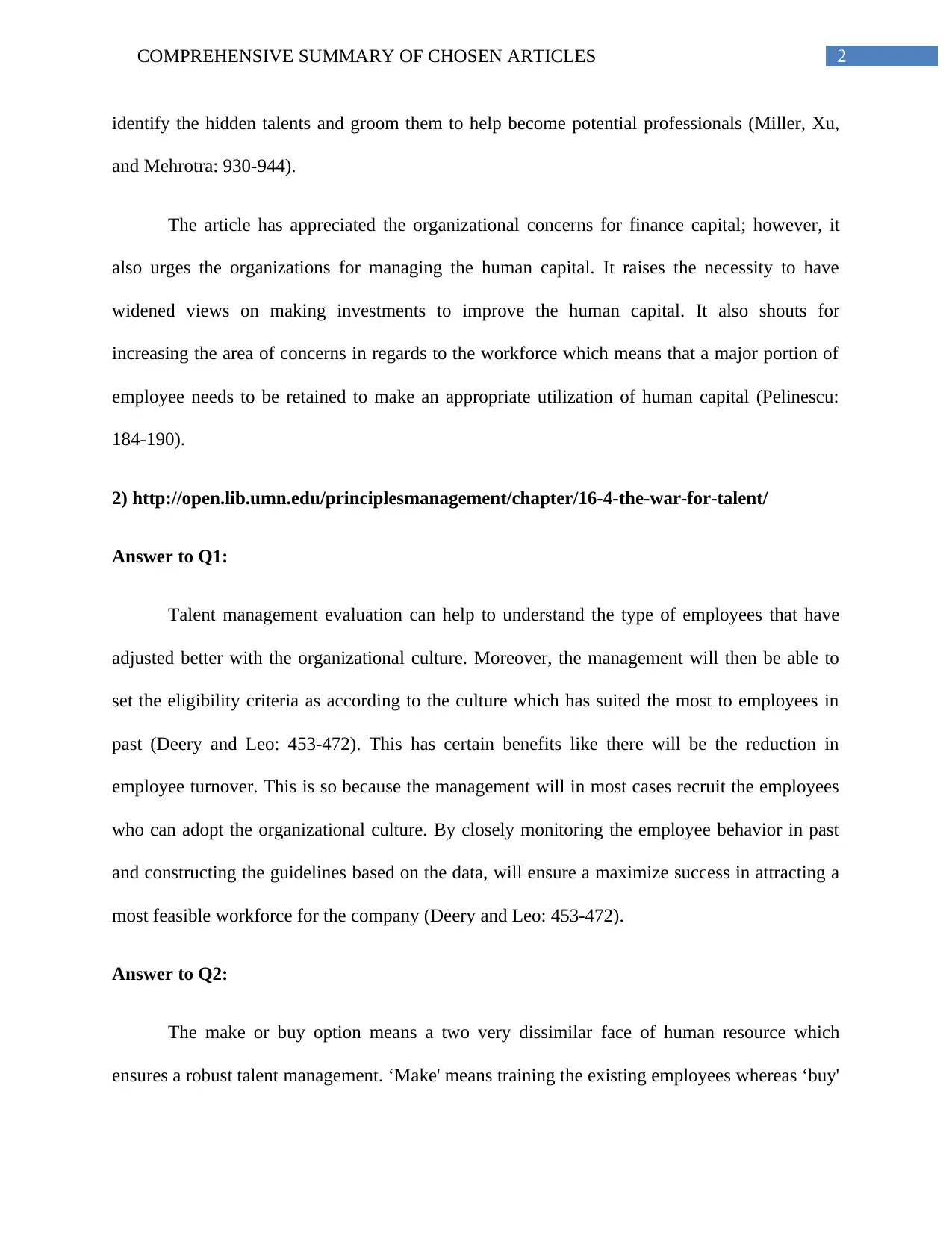
2COMPREHENSIVE SUMMARY OF CHOSEN ARTICLES
identify the hidden talents and groom them to help become potential professionals (Miller, Xu,
and Mehrotra: 930-944).
The article has appreciated the organizational concerns for finance capital; however, it
also urges the organizations for managing the human capital. It raises the necessity to have
widened views on making investments to improve the human capital. It also shouts for
increasing the area of concerns in regards to the workforce which means that a major portion of
employee needs to be retained to make an appropriate utilization of human capital (Pelinescu:
184-190).
2) http://open.lib.umn.edu/principlesmanagement/chapter/16-4-the-war-for-talent/
Answer to Q1:
Talent management evaluation can help to understand the type of employees that have
adjusted better with the organizational culture. Moreover, the management will then be able to
set the eligibility criteria as according to the culture which has suited the most to employees in
past (Deery and Leo: 453-472). This has certain benefits like there will be the reduction in
employee turnover. This is so because the management will in most cases recruit the employees
who can adopt the organizational culture. By closely monitoring the employee behavior in past
and constructing the guidelines based on the data, will ensure a maximize success in attracting a
most feasible workforce for the company (Deery and Leo: 453-472).
Answer to Q2:
The make or buy option means a two very dissimilar face of human resource which
ensures a robust talent management. ‘Make' means training the existing employees whereas ‘buy'
identify the hidden talents and groom them to help become potential professionals (Miller, Xu,
and Mehrotra: 930-944).
The article has appreciated the organizational concerns for finance capital; however, it
also urges the organizations for managing the human capital. It raises the necessity to have
widened views on making investments to improve the human capital. It also shouts for
increasing the area of concerns in regards to the workforce which means that a major portion of
employee needs to be retained to make an appropriate utilization of human capital (Pelinescu:
184-190).
2) http://open.lib.umn.edu/principlesmanagement/chapter/16-4-the-war-for-talent/
Answer to Q1:
Talent management evaluation can help to understand the type of employees that have
adjusted better with the organizational culture. Moreover, the management will then be able to
set the eligibility criteria as according to the culture which has suited the most to employees in
past (Deery and Leo: 453-472). This has certain benefits like there will be the reduction in
employee turnover. This is so because the management will in most cases recruit the employees
who can adopt the organizational culture. By closely monitoring the employee behavior in past
and constructing the guidelines based on the data, will ensure a maximize success in attracting a
most feasible workforce for the company (Deery and Leo: 453-472).
Answer to Q2:
The make or buy option means a two very dissimilar face of human resource which
ensures a robust talent management. ‘Make' means training the existing employees whereas ‘buy'
⊘ This is a preview!⊘
Do you want full access?
Subscribe today to unlock all pages.

Trusted by 1+ million students worldwide
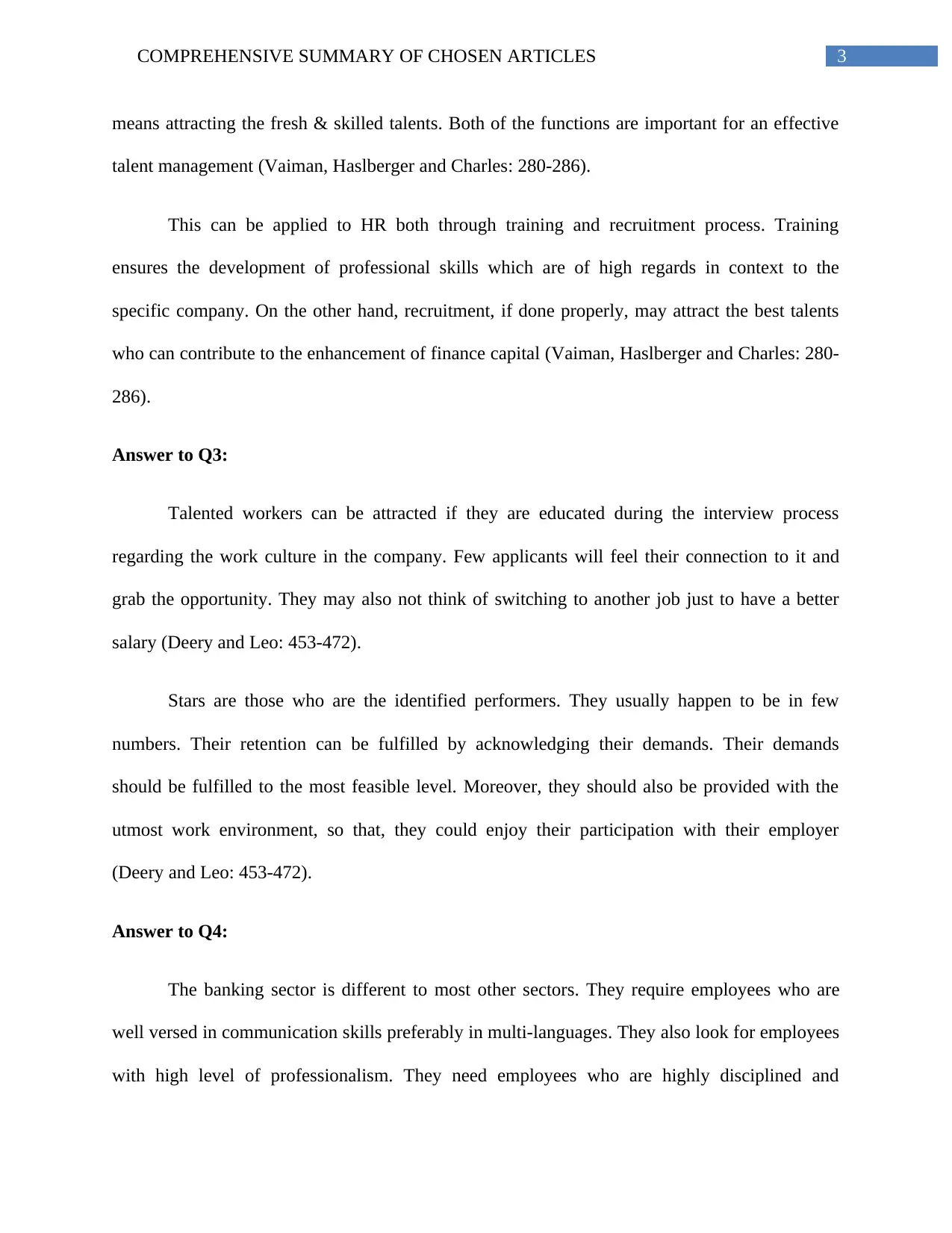
3COMPREHENSIVE SUMMARY OF CHOSEN ARTICLES
means attracting the fresh & skilled talents. Both of the functions are important for an effective
talent management (Vaiman, Haslberger and Charles: 280-286).
This can be applied to HR both through training and recruitment process. Training
ensures the development of professional skills which are of high regards in context to the
specific company. On the other hand, recruitment, if done properly, may attract the best talents
who can contribute to the enhancement of finance capital (Vaiman, Haslberger and Charles: 280-
286).
Answer to Q3:
Talented workers can be attracted if they are educated during the interview process
regarding the work culture in the company. Few applicants will feel their connection to it and
grab the opportunity. They may also not think of switching to another job just to have a better
salary (Deery and Leo: 453-472).
Stars are those who are the identified performers. They usually happen to be in few
numbers. Their retention can be fulfilled by acknowledging their demands. Their demands
should be fulfilled to the most feasible level. Moreover, they should also be provided with the
utmost work environment, so that, they could enjoy their participation with their employer
(Deery and Leo: 453-472).
Answer to Q4:
The banking sector is different to most other sectors. They require employees who are
well versed in communication skills preferably in multi-languages. They also look for employees
with high level of professionalism. They need employees who are highly disciplined and
means attracting the fresh & skilled talents. Both of the functions are important for an effective
talent management (Vaiman, Haslberger and Charles: 280-286).
This can be applied to HR both through training and recruitment process. Training
ensures the development of professional skills which are of high regards in context to the
specific company. On the other hand, recruitment, if done properly, may attract the best talents
who can contribute to the enhancement of finance capital (Vaiman, Haslberger and Charles: 280-
286).
Answer to Q3:
Talented workers can be attracted if they are educated during the interview process
regarding the work culture in the company. Few applicants will feel their connection to it and
grab the opportunity. They may also not think of switching to another job just to have a better
salary (Deery and Leo: 453-472).
Stars are those who are the identified performers. They usually happen to be in few
numbers. Their retention can be fulfilled by acknowledging their demands. Their demands
should be fulfilled to the most feasible level. Moreover, they should also be provided with the
utmost work environment, so that, they could enjoy their participation with their employer
(Deery and Leo: 453-472).
Answer to Q4:
The banking sector is different to most other sectors. They require employees who are
well versed in communication skills preferably in multi-languages. They also look for employees
with high level of professionalism. They need employees who are highly disciplined and
Paraphrase This Document
Need a fresh take? Get an instant paraphrase of this document with our AI Paraphraser
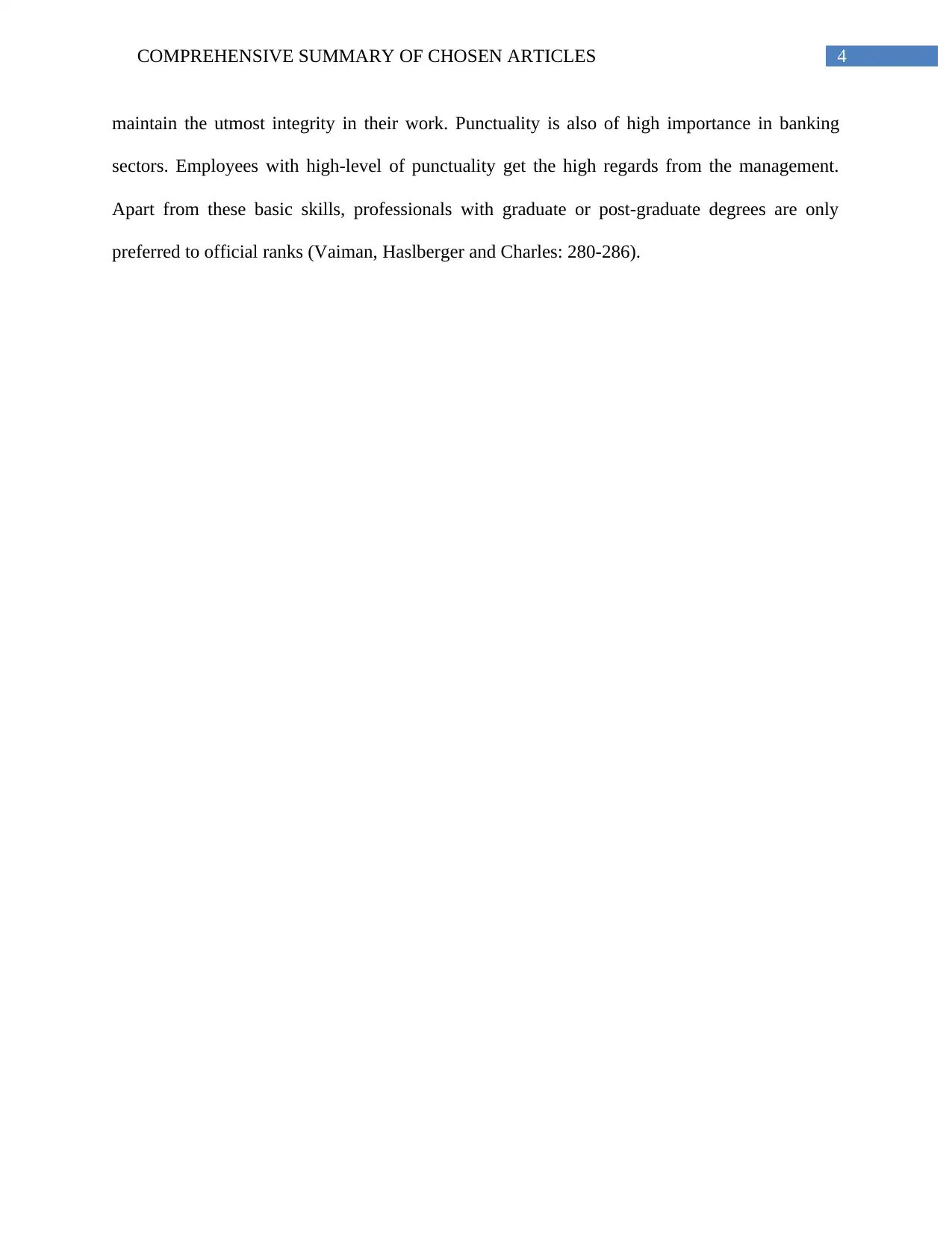
4COMPREHENSIVE SUMMARY OF CHOSEN ARTICLES
maintain the utmost integrity in their work. Punctuality is also of high importance in banking
sectors. Employees with high-level of punctuality get the high regards from the management.
Apart from these basic skills, professionals with graduate or post-graduate degrees are only
preferred to official ranks (Vaiman, Haslberger and Charles: 280-286).
maintain the utmost integrity in their work. Punctuality is also of high importance in banking
sectors. Employees with high-level of punctuality get the high regards from the management.
Apart from these basic skills, professionals with graduate or post-graduate degrees are only
preferred to official ranks (Vaiman, Haslberger and Charles: 280-286).
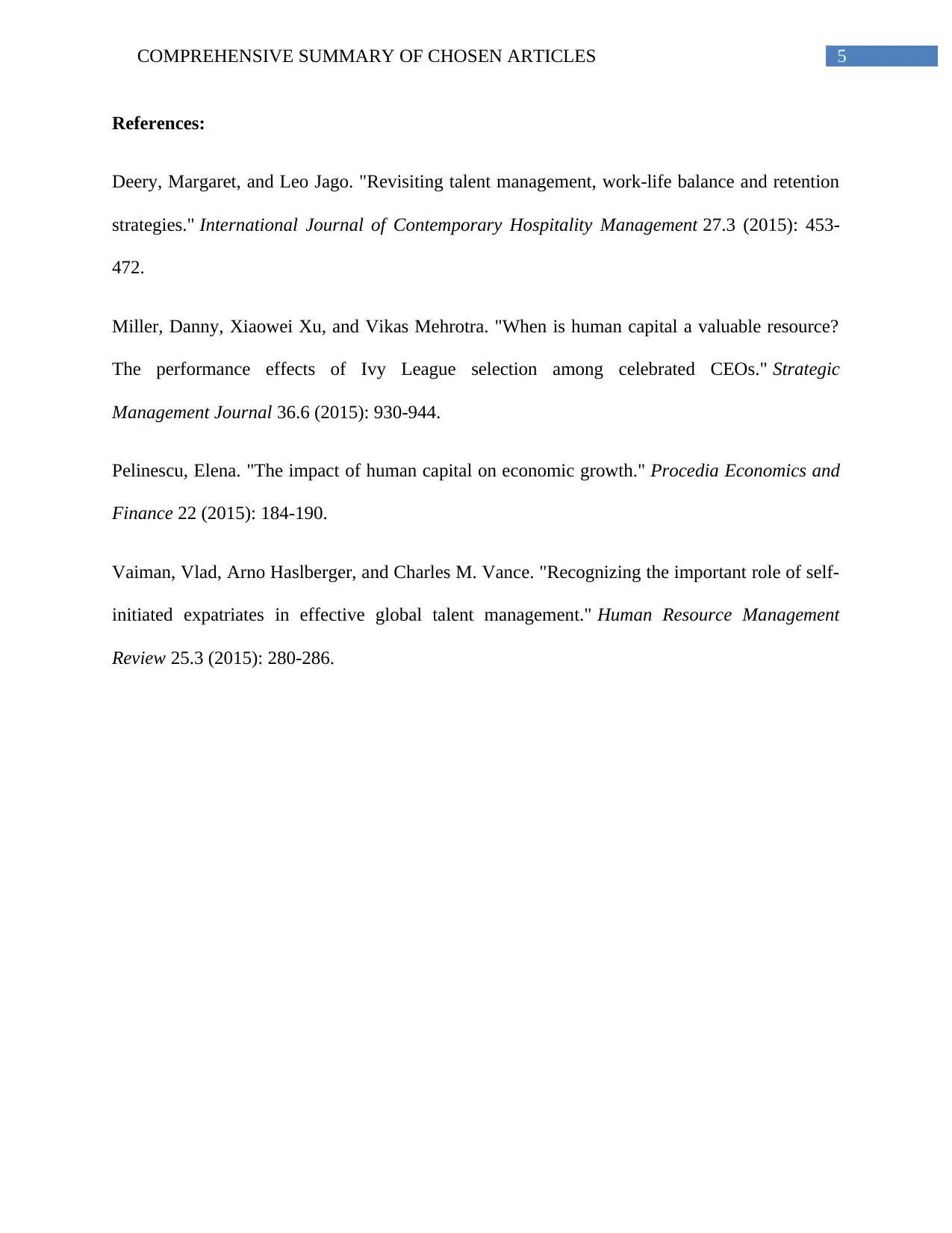
5COMPREHENSIVE SUMMARY OF CHOSEN ARTICLES
References:
Deery, Margaret, and Leo Jago. "Revisiting talent management, work-life balance and retention
strategies." International Journal of Contemporary Hospitality Management 27.3 (2015): 453-
472.
Miller, Danny, Xiaowei Xu, and Vikas Mehrotra. "When is human capital a valuable resource?
The performance effects of Ivy League selection among celebrated CEOs." Strategic
Management Journal 36.6 (2015): 930-944.
Pelinescu, Elena. "The impact of human capital on economic growth." Procedia Economics and
Finance 22 (2015): 184-190.
Vaiman, Vlad, Arno Haslberger, and Charles M. Vance. "Recognizing the important role of self-
initiated expatriates in effective global talent management." Human Resource Management
Review 25.3 (2015): 280-286.
References:
Deery, Margaret, and Leo Jago. "Revisiting talent management, work-life balance and retention
strategies." International Journal of Contemporary Hospitality Management 27.3 (2015): 453-
472.
Miller, Danny, Xiaowei Xu, and Vikas Mehrotra. "When is human capital a valuable resource?
The performance effects of Ivy League selection among celebrated CEOs." Strategic
Management Journal 36.6 (2015): 930-944.
Pelinescu, Elena. "The impact of human capital on economic growth." Procedia Economics and
Finance 22 (2015): 184-190.
Vaiman, Vlad, Arno Haslberger, and Charles M. Vance. "Recognizing the important role of self-
initiated expatriates in effective global talent management." Human Resource Management
Review 25.3 (2015): 280-286.
⊘ This is a preview!⊘
Do you want full access?
Subscribe today to unlock all pages.

Trusted by 1+ million students worldwide
1 out of 6
Your All-in-One AI-Powered Toolkit for Academic Success.
+13062052269
info@desklib.com
Available 24*7 on WhatsApp / Email
![[object Object]](/_next/static/media/star-bottom.7253800d.svg)
Unlock your academic potential
Copyright © 2020–2025 A2Z Services. All Rights Reserved. Developed and managed by ZUCOL.